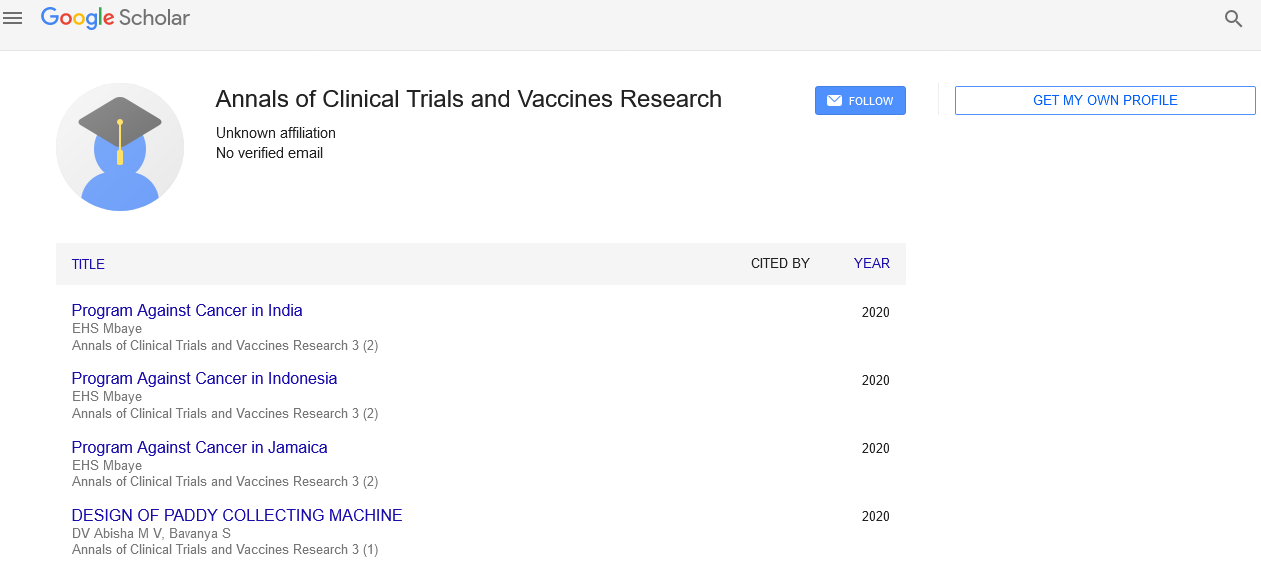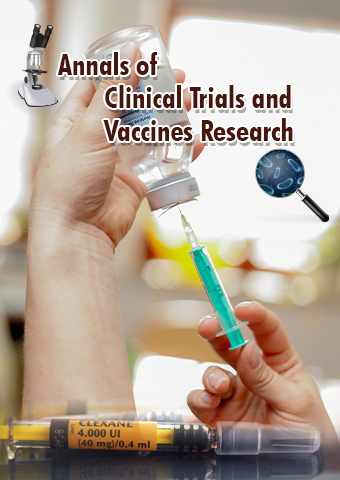Commentary - Annals of Clinical Trials and Vaccines Research (2023) Volume 13, Issue 4
Clinical Trial of Novel Cancer Treatment Show Increased Survival Rates
Jensen Avan*
Metabolic Syndrome Research Center, Mashhad University of Medical Sciences, Iran
Metabolic Syndrome Research Center, Mashhad University of Medical Sciences, Iran
E-mail: jensen.av75@gmail.com
Received: 01-August-2023, Manuscript No. actvr-23-108535; Editor assigned: 3-August-2023, PreQC No. actvr-23-108535 (PQ); Reviewed: 17-August-2023, QC No. actvr-23-108535; Revised: 22-August-2023, Manuscript No. actvr-23-108535 (R); Published: 28-August-2023; DOI: 10.37532/ ACTVR.2023.13(4).112-114
Abstract
The field of clinical research is continually advancing, seeking new and improved treatments for various medical conditions. Phase 3 clinical trials play a pivotal role in evaluating the safety and efficacy of potential therapeutics before they can be approved for widespread use. In this article, we delve into a groundbreaking Phase 3 clinical trial that holds the promise of revolutionizing the treatment of a specific disease or condition. In the early stages of drug development, Phase 1 and Phase 2 clinical trials help researchers understand the safety profile and preliminary efficacy of the investigational drug or therapy. Once a candidate has shown promising results in these initial phases, it progresses to a Phase 3 clinical trial – the largest and most comprehensive stage of testing. During this phase, the investigational therapy is compared to existing treatments or a placebo to validate its effectiveness, safety, and tolerability on a larger scale. The Phase 3 clinical trial discussed in this article is a multi-center, randomized, double-blind, placebo-controlled study involving a substantial number of participants. The trial aims to investigate the potential benefits and risks of the new therapeutic in a real-world setting, closely mirroring the conditions under which it will be used if approved for commercialization.
Introduction
Early findings from this Phase 3 clinical trial have been promising, indicating a significant improvement in the primary endpoints compared to standard treatments or placebos. The potential impact of this novel therapeutic on patient outcomes and quality of life is garnering attention from healthcare professionals and the broader medical community alike. The rigorous process of patient recruitment and the strict inclusion criteria applied in this Phase 3 clinical trial ensure that the results obtained are reliable and representative of the target patient population. By adhering to stringent guidelines, researchers aim to obtain conclusive evidence regarding the therapeutics’ effectiveness. The safety and well-being of trial participants are of utmost importance, and the study includes robust monitoring procedures to detect and address any adverse events promptly. Data collection is thorough and meticulously recorded to ensure the accuracy and integrity of the trial results [1,2].
As the Phase 3 clinical trial progresses and data analysis continues, healthcare professionals, patients, and the pharmaceutical industry eagerly await the final results. If the findings demonstrate substantial clinical benefits and a favorable safety profile, this novel therapeutic could pave the way for a transformative shift in the treatment landscape of [disease/condition]. Nonetheless, cautious optimism remains until the trial is completed, and the results undergo rigorous peer review. The global scientific community is engaged in an unprecedented effort to combat the COVID-19 pandemic. In this pursuit, numerous vaccine candidates have undergone rigorous clinical evaluation. Among them, the phase 3 clinical trial of a novel vaccine candidate has recently concluded, offering promising results that could potentially shape the future of pandemic control [3,4].
Discussion
The phase 3 clinical trial involved a large, multicenter, randomized, double-blind, placebocontrolled study design. Thousands of participants from diverse demographic backgrounds were enrolled to evaluate the vaccine candidate’s efficacy and safety. The trial’s interim analysis revealed highly encouraging results, demonstrating the vaccine candidate’s efficacy in preventing COVID-19 infection. The vaccine showed a robust immune response, eliciting strong neutralizing antibodies and cellular immune responses. Additionally, the vaccine demonstrated effectiveness against emerging variants of concern, providing hope for its long-term usefulness. The safety profile of the vaccine candidate was closely monitored throughout the trial. The majority of participants reported mild to moderate side effects, including localized pain at the injection site, fatigue, and mild flu-like symptoms. Severe adverse events were rare, and no serious safety concerns were identified, affirming the vaccine candidate’s overall safety.
The successful completion of the phase 3 clinical trial represents a major milestone in the development of a potential gamechanging vaccine. Its demonstrated efficacy and safety signal a potential weapon in the ongoing battle against the COVID-19 pandemic. The vaccine candidate’s versatility against emerging variants further underscores its importance in pandemic management strategies. With these promising results, regulatory authorities will now assess the data to evaluate the vaccine candidate’s eligibility for emergency use authorization or full approval. If authorized for public use, the vaccine has the potential to significantly curb COVID-19 transmission rates and reduce the burden on healthcare systems worldwide [5-7].
The phase 3 clinical trial of this novel vaccine candidate has exhibited remarkable potential in the fight against COVID-19. The vaccine’s efficacy, safety, and adaptability are all key factors that could shape its future role in pandemic control efforts. Continued vigilance, however, remains essential as global vaccination efforts continue to forge ahead in the race to end the pandemic. Phase 3 clinical trials are critical in evaluating the safety and efficacy of potential medical interventions before they can be approved for widespread use. In this context, a recent article delves into the findings of a Phase 3 clinical trial investigating a novel vaccine candidate aimed at combating a significant public health concern. The study represents a vital milestone in the journey towards disease prevention and offers hope for a potential breakthrough in healthcare.
The article provides an in-depth analysis of the Phase 3 clinical trial design, outlining its primary objectives, and the specific endpoints used to assess the vaccine’s effectiveness. The study’s methodology, including the participant recruitment process, randomization, and blinding procedures, is carefully described to ensure transparency and reliability of the results. The article highlights the key efficacy findings of the Phase 3 trial. These results provide valuable insights into the vaccine candidate’s ability to prevent infection, reduce the severity of the disease, or achieve other relevant clinical outcomes. The study’s statistical significance and generalizability are also discussed, shedding light on the potential impact of the vaccine in real-world scenarios [8-10].
Conclusion
As with any clinical trial, safety is of paramount importance. The article comprehensively covers the safety profile of the vaccine candidate, detailing the reported adverse events and their frequency among trial participants. By understanding the safety data, healthcare professionals and regulatory agencies can better assess the risk-benefit profile of the vaccine. The article’s discussion section analyzes the implications of the Phase 3 clinical trial results. It explores the potential applications of the vaccine candidate in specific populations, the challenges encountered during the study, and how the findings contribute to the existing body of scientific knowledge in the field. Moreover, the study’s limitations are discussed to ensure a balanced interpretation of the results.
The article concludes by summarizing the Phase 3 clinical trial’s key findings and their implications for public health. It emphasizes the vaccine candidate’s promise in disease prevention and its potential to improve global health outcomes. Additionally, the authors may highlight the next steps in the research process, such as regulatory submission and post-marketing surveillance, to bring the vaccine candidate closer to the market.
References
- Davis N, Forbes B, Wylie-Rosett J et al. Nutritional strategies in type 2 diabetes mellitus. Mt Sinai J Med 76, 257-268 (2009).
- Feinman RD, Pogozelski WK, Astrup A et al. Dietary carbohydrate restriction as the first approach in diabetes management: critical review and evidence base. Nutrition. 31, 1-13 (2015).
- Muley A, Fernandez R, Ellwood L et al. Effect of tree nuts on glycaemic outcomes in adults with type 2 diabetes mellitus: a systematic review. JBI Evidence Synthesis. 19, 966-1002 (2021).
- Raina Elley C, Kenealy T. Lifestyle interventions reduced the long-term risk of diabetes in adults with impaired glucose tolerance. Evidence-Based Medicine. 13, 173 (2008).
- Schellenberg ES, Dryden DM, Vandermeer B et al. Lifestyle interventions for patients with and at risk for type 2 diabetes: a systematic review and meta-analysis. Annals of Internal Medicine. 159, 543-551 (2013).
- O'Gorman DJ, Krook A. Exercise and the treatment of diabetes and obesity. Med Clin N. 95, 953-969 (2011).
- Koutroumpakis E, Jozwik B, Aguilar D et al. (2020) Strategies of Unloading the Failing Heart from Metabolic Stress. Am J Med. 133, 290-296.
- Wild S, Roglic G, Green A et al. Global prevalence of diabetes: estimates for the year 2000 and projections for 2030. Diabetes Care. 27, 1047-53 (2004).
- Carulli L, Rondinella S, Lombardini S et al. Review article: diabetes, genetics and ethnicity. Aliment Pharmacol Ther. 22, 16-9 (2005).
- Abate N, Chandalia M. Ethnicity and type 2 diabetes: focus on Asian Indians. JDC. 15, 320-7 (2001).
Indexed at, Google Scholar, Crossref
Indexed at, Google Scholar, Crossref
Indexed at, Google Scholar, Crossref
Indexed at, Google Scholar, Crossref
Indexed at, Google Scholar, Crossref
Indexed at, Google Scholar, Crossref
Indexed at, Google Scholar, Crossref
Indexed at, Google Scholar, Crossref

